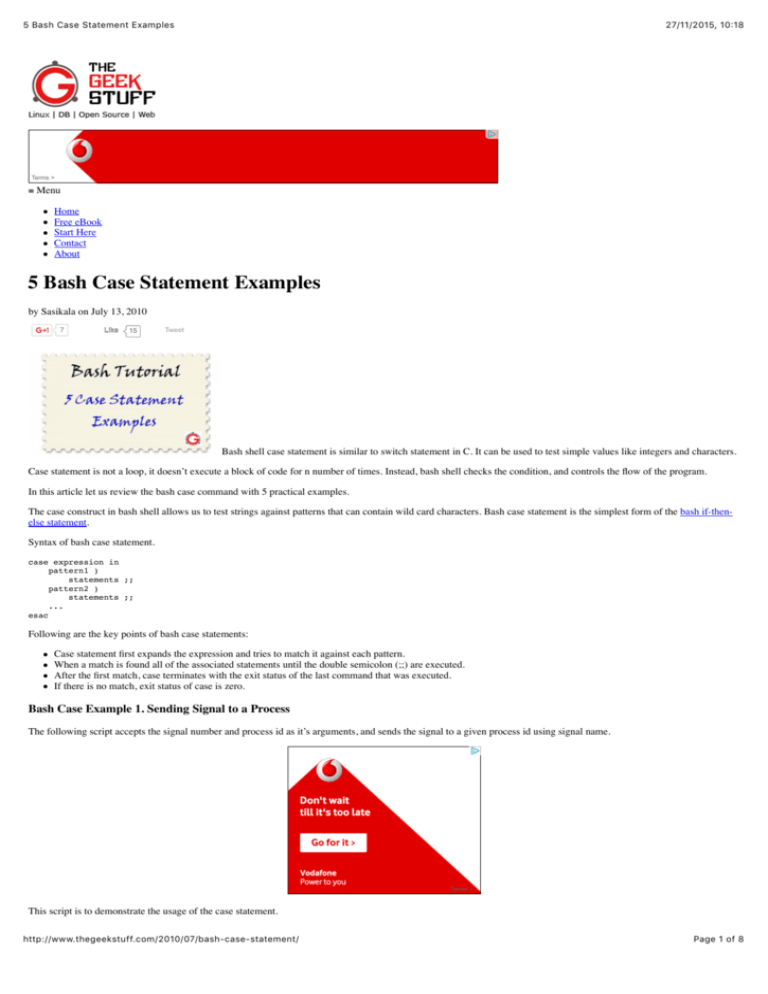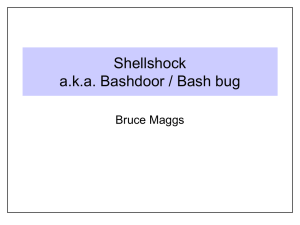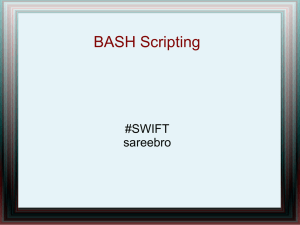
5 Bash Case Statement Examples
27/11/2015, 10:18
Terms >
≡ Menu
Home
Free eBook
Start Here
Contact
About
5 Bash Case Statement Examples
by Sasikala on July 13, 2010
7
Like
15
Tweet
Bash shell case statement is similar to switch statement in C. It can be used to test simple values like integers and characters.
Case statement is not a loop, it doesn’t execute a block of code for n number of times. Instead, bash shell checks the condition, and controls the flow of the program.
In this article let us review the bash case command with 5 practical examples.
The case construct in bash shell allows us to test strings against patterns that can contain wild card characters. Bash case statement is the simplest form of the bash if-thenelse statement.
Syntax of bash case statement.
case expression in
pattern1 )
statements ;;
pattern2 )
statements ;;
...
esac
Following are the key points of bash case statements:
Case statement first expands the expression and tries to match it against each pattern.
When a match is found all of the associated statements until the double semicolon (;;) are executed.
After the first match, case terminates with the exit status of the last command that was executed.
If there is no match, exit status of case is zero.
Bash Case Example 1. Sending Signal to a Process
The following script accepts the signal number and process id as it’s arguments, and sends the signal to a given process id using signal name.
Terms >
This script is to demonstrate the usage of the case statement.
http://www.thegeekstuff.com/2010/07/bash-case-statement/
Page 1 of 8
5 Bash Case Statement Examples
27/11/2015, 10:18
$ cat signal.sh
#!/bin/bash
if [ $# -lt 2 ]
then
echo "Usage : $0 Signalnumber PID"
exit
fi
case "$1" in
1)
echo "Sending SIGHUP signal"
kill -SIGHUP $2
;;
2) echo "Sending SIGINT signal"
kill -SIGINT $2
;;
3) echo "Sending SIGQUIT signal"
kill -SIGQUIT $2
;;
9) echo "Sending SIGKILL signal"
kill -SIGKILL $2
;;
*) echo "Signal number $1 is not processed"
;;
esac
In the above example:
$1 and $2 are the signal number and process id respectively.
Using kill command, it sends the corresponding signal to the given process id.
It executes the sleep command for a number of seconds.
The optional last comparison *) is a default case and that matches anything.
Usage of the above shell script: Find out the process id of the sleep command and send kill signal to that process id to kill the process.
$ sleep 1000
$ ps -a | grep sleep
23277 pts/2
00:00:00 sleep
$ ./signal.sh 9 23277
Sending SIGKILL signal
$ sleep 1000
Killed
Also, refer to our earlier kill article – 4 methods to kill a process.
Bash Case Example. 2. Pattern Match in a File
This example prints the number of lines,number of words and delete the lines that matches the given pattern.
$ cat fileop.sh
#!/bin/bash
# Check 3 arguments are given #
if [ $# -lt 3 ]
then
echo "Usage : $0 option pattern filename"
exit
fi
# Check the given file is exist #
if [ ! -f $3 ]
then
echo "Filename given \"$3\" doesn't exist"
exit
fi
case "$1" in
# Count number of lines matches
-i) echo "Number of lines matches with the pattern $2 :"
grep -c -i $2 $3
;;
# Count number of words matches
-c) echo "Number of words matches with the pattern $2 :"
grep -o -i $2 $3 | wc -l
;;
# print all the matched lines
-p) echo "Lines matches with the pattern $2 :"
grep -i $2 $3
;;
# Delete all the lines matches with the pattern
-d) echo "After deleting the lines matches with the pattern $2 :"
sed -n "/$2/!p" $3
;;
*) echo "Invalid option"
;;
esac
Execution of the above script is shown below.
http://www.thegeekstuff.com/2010/07/bash-case-statement/
Page 2 of 8
5 Bash Case Statement Examples
27/11/2015, 10:18
$ cat text
Vim is a text editor released by Bram Moolenaar in 1991 for the Amiga computer.
The name "Vim" is an acronym for "Vi IMproved" because Vim was created as an extended version of the vi editor, with many additional features desig
Although Vim was originally released for the Amiga, Vim has since been developed to be cross-platform, supporting many other platforms.
It is the most popular editor amongst Linux Journal readers.
Bash case regex output. After deleting the lines matches with the pattern Vim:
$ ./fileop.sh -d Vim text
It is the most popular editor amongst Linux Journal readers.
Also, refer to our earlier article on Bash ~ expansaion and { } expansion.
Bash Case Example 3. Find File type from the Extension
This example prints type of a file (text, Csource, etc) based on the extension of the filename.
$ cat filetype.sh
#!/bin/bash
for filename in $(ls)
do
# Take extension available in a filename
ext=${filename##*\.}
case "$ext" in
c) echo "$filename : C source file"
;;
o) echo "$filename : Object file"
;;
sh) echo "$filename : Shell script"
;;
txt) echo "$filename : Text file"
;;
*) echo " $filename : Not processed"
;;
esac
done
$ ./filetype.sh
a.c : C source file
b.c : C source file
c1.txt : Text file
fileop.sh : Shell script
obj.o : Object file
text : Not processed
t.o : Object file
Bash Case Example 4. Prompt User with Yes or No
In most of the software installation, during license agreement, it will ask yes or no input from user. The following code snippet is one of the way to get the yes or no input
from user.
$ cat yorno.sh
#!/bin/bash
echo -n "Do you agree with this? [yes or no]: "
read yno
case $yno in
[yY] | [yY][Ee][Ss] )
echo "Agreed"
;;
[nN] | [n|N][O|o] )
echo "Not agreed, you can't proceed the installation";
exit 1
;;
*) echo "Invalid input"
;;
esac
$ ./yorno.sh
Do you agree with this? [yes or no]: YES
Agreed
If there are several patterns separated by pipe characters, the expression can match any of them in order for the associated statements to be run. The patterns are checked in
order until a match is found; if none is found, nothing happens.
Also, refer to our earlier 15 bash array examples article.
Bash Case Example 5. Startup script
Startup scripts in the /etc/init.d directory uses the case statement to start and stop the application.
You can use any kind of patterns, but its always recommended to use case statement, when you’re testing on values of primitives. (ie. integers or characters).
$ cat startpcapp
#!/bin/bash
case "$1" in
'start')
echo "Starting application"
/usr/bin/startpc
http://www.thegeekstuff.com/2010/07/bash-case-statement/
Page 3 of 8
5 Bash Case Statement Examples
27/11/2015, 10:18
;;
'stop')
echo "Stopping application"
/usr/bin/stoppc
;;
'restart')
echo "Usage: $0 [start|stop]"
;;
esac
$ ./startpcapp start
Starting application
/usr/bin/startpc started
Recommended Reading
Bash 101 Hacks, by Ramesh Natarajan. I spend most of my time on Linux environment. So, naturally I’m a huge fan of Bash command line and
shell scripting. 15 years back, when I was working on different flavors of *nix, I used to write lot of code on C shell and Korn shell. Later years, when I started working on
Linux as system administrator, I pretty much automated every possible task using Bash shell scripting. Based on my Bash experience, I’ve written Bash 101 Hacks eBook
that contains 101 practical examples on both Bash command line and shell scripting. If you’ve been thinking about mastering Bash, do yourself a favor and read this book,
which will help you take control of your Bash command line and shell scripting.
7
Tweet
Like
15
> Add your comment
If you enjoyed this article, you might also like..
1.
2.
3.
4.
5.
50 Linux Sysadmin Tutorials
50 Most Frequently Used Linux Commands (With Examples)
Top 25 Best Linux Performance Monitoring and Debugging Tools
Mommy, I found it! – 15 Practical Linux Find Command Examples
Linux 101 Hacks 2nd Edition eBook
Awk Introduction – 7 Awk Print Examples
Advanced Sed Substitution Examples
8 Essential Vim Editor Navigation Fundamentals
25 Most Frequently Used Linux IPTables Rules Examples
Turbocharge PuTTY with 12 Powerful Add-Ons
Tagged as: Bash case command, Bash case esac, Bash case multiple, Bash case switch, Bash Tutorial
{ 11 comments… add one }
Chris F.A. Johnson July 13, 2010, 7:42 am
> case expression in
The first argument to case is NOT an expression it is a string (or ‘word’, to quote the bash man page).
> for filename in $(ls)
Not only is ‘ls’ unnecessary, but it will break the script if any filenames contain whitespace or other pathological characters.
Link
SilversleevesX August 2, 2010, 8:21 am
Your example 4 (file type by extension) makes no provision for when an item in the folder happens to be a directory. I suggest this little conditional tweak to keep the
script (and folks who use it to learn case/esac statements) from getting confused.
regordir=$(stat -c %F $filename)
if [[ $regordir != “directory” ]];
then…
(your list of file types and labels here)…
fi
Test your own out line by line with this series of one-liners and variable setters in a terminal/console:
http://www.thegeekstuff.com/2010/07/bash-case-statement/
Page 4 of 8
5 Bash Case Statement Examples
27/11/2015, 10:18
>> filename=”sandwich.txt”
>> regordir=$(stat -c %F $filename)
>> if [[ $regoderdir != “directory” ]]; then echo “I am not a folder “‘!'; else echo “Well, I guess I AM a folder, after all.”;fi
A mere suggestion. Take what you like and leave the rest.
Cheers,
BZT
Link
Brian C July 28, 2011, 1:56 pm
Thanks for the tips.
In example 4 there appears to be a typo. The vertical bar doesn’t belong when checking the “NO”, “no”, “No”, or “nO”
I.E. This: [nN] | [n|N][O|o] ) Should be this: [nN] | [nN][Oo] )
Link
s kumar September 1, 2011, 12:35 am
1. Give two amount find the %?\
2.Two convert centigrade to Fahrenheit
3. Calculate are of a circle
all above que. using by the shell programming
Link
shweta October 22, 2012, 10:51 pm
#!/bin/bash
echo “enter the value”
read a
case $a in
1) echo ” 1 ” ;&
2) echo ” 2 ” ;&
3) echo ” 3 ” ;;&
4) echo ” 4 ” ;;
5) echo ” 5 ” ;&
esac
i m a beginner in Shell Scripting , anybody can explain me, how these “;;&” , “;&” , “;;” terminator different from each other and how they work?
Link
Chris F.A. Johnson October 22, 2012, 11:23 pm
From the bash man page:
Using ;& in place of ;; causes execution to continue with the list associated with the next set of patterns. Using ;;& in place of ;; causes the shell to test the next
pattern list in the statement, if any, and execute any associated list on a successful match. The exit status is zero if no pattern matches. Otherwise, it is the exit status
of the last command executed in list.
Link
shweta October 31, 2012, 9:19 am
@ Chris F.A. Johnson, thanx… ,i have one more confusion….. can u help
if test $# = 3
then
case $2 in
/) z=$(($1/$3));;
x|X) z=$(($1*$3));;
+) z=$(($1+$3));;
-) z=$(($1-$3));;
*) echo “warning – $2 invalid operator, pls use X or x”;;
esac
echo “$1 $2 $3 = $z”
else
echo “Pls Enter 3 values”
fi
./Math.sh 3 * 33
output
Pls Enter 3 values
I m not able 2 figure it out why this output, i m expecting ” “warning – $2 invalid operator, pls use X or x”
Link
Chris F.A. Johnson October 31, 2012, 11:51 am
Escape the asterisk or it will be expanded.
Link
Ashish July 28, 2013, 11:32 pm
Below is the content of file1.txt
http://www.thegeekstuff.com/2010/07/bash-case-statement/
Page 5 of 8
5 Bash Case Statement Examples
27/11/2015, 10:18
Dept Coll Score Grade
ECE AIHT 90 A+
CSC SSN 86 B
MEC AVIT 88 B+
EEE PSN 84 C
Write one shell script for below requirement
a. Get the column name as input during runtime (Dept of Coll or Score or Grade)
Example…
If you enter Coll in input during runtime, output should be as
AIHT
SSN
AVIT
PSN
If you enter Dept in during runtime, output should be as
ECE
CSC
MEC
EEE
b. If you enter invalid column name script should throw error
Try doing it with, if or case statement and awk or grep commands.
Link
Dinesh Kumar July 29, 2014, 5:48 am
Hi,
Thank you for all the amazing stuff on this website.
For the example 4, is there any reason why we are not using the ‘shopt’ s (shopt -s nocasematch)?
We could be setting ignore case and then unset it back. Is there any reason why this has to be avoided, because i usually use it in my little scripts.
Thanks in advance.
Link
KHALIQ February 8, 2015, 3:37 pm
In a unix directory there are five applications and qa,init,prod when i run a start.sh it should pick up whatever env I give .can any one write the script and sendit to my
mail please .with unix case statement..
Link
Leave a Comment
Name
Email
Website
Comment
Submit
Notify me of followup comments via e-mail
Next post: HowTo: The Ultimate Logrotate Command Tutorial with 10 Examples
Previous post: VMware: How to Create Virtual Machine and Install Guest OS using vSphere Client
RSS | Email | Twitter | Facebook | Google+
Search
http://www.thegeekstuff.com/2010/07/bash-case-statement/
Page 6 of 8
5 Bash Case Statement Examples
27/11/2015, 10:18
EBOOKS
Linux 101 Hacks 2nd Edition eBook - Practical Examples to Build a Strong Foundation in Linux
Bash 101 Hacks eBook - Take Control of Your Bash Command Line and Shell Scripting
Sed and Awk 101 Hacks eBook - Enhance Your UNIX / Linux Life with Sed and Awk
Vim 101 Hacks eBook - Practical Examples for Becoming Fast and Productive in Vim Editor
Nagios Core 3 eBook - Monitor Everything, Be Proactive, and Sleep Well
The Geek Stuff
13,064 likes
Like Page
Share
Be the first of your friends to like this
POPULAR POSTS
12 Amazing and Essential Linux Books To Enrich Your Brain and Library
50 UNIX / Linux Sysadmin Tutorials
50 Most Frequently Used UNIX / Linux Commands (With Examples)
How To Be Productive and Get Things Done Using GTD
30 Things To Do When you are Bored and have a Computer
Linux Directory Structure (File System Structure) Explained with Examples
Linux Crontab: 15 Awesome Cron Job Examples
Get a Grip on the Grep! – 15 Practical Grep Command Examples
Unix LS Command: 15 Practical Examples
15 Examples To Master Linux Command Line History
Top 10 Open Source Bug Tracking System
Vi and Vim Macro Tutorial: How To Record and Play
Mommy, I found it! -- 15 Practical Linux Find Command Examples
15 Awesome Gmail Tips and Tricks
15 Awesome Google Search Tips and Tricks
RAID 0, RAID 1, RAID 5, RAID 10 Explained with Diagrams
Can You Top This? 15 Practical Linux Top Command Examples
Top 5 Best System Monitoring Tools
Top 5 Best Linux OS Distributions
How To Monitor Remote Linux Host using Nagios 3.0
Awk Introduction Tutorial – 7 Awk Print Examples
How to Backup Linux? 15 rsync Command Examples
The Ultimate Wget Download Guide With 15 Awesome Examples
Top 5 Best Linux Text Editors
Packet Analyzer: 15 TCPDUMP Command Examples
The Ultimate Bash Array Tutorial with 15 Examples
3 Steps to Perform SSH Login Without Password Using ssh-keygen & ssh-copy-id
Unix Sed Tutorial: Advanced Sed Substitution Examples
UNIX / Linux: 10 Netstat Command Examples
The Ultimate Guide for Creating Strong Passwords
6 Steps to Secure Your Home Wireless Network
Turbocharge PuTTY with 12 Powerful Add-Ons
CATEGORIES
Linux Tutorials
Vim Editor
Sed Scripting
Awk Scripting
Bash Shell Scripting
Nagios Monitoring
http://www.thegeekstuff.com/2010/07/bash-case-statement/
Page 7 of 8
5 Bash Case Statement Examples
27/11/2015, 10:18
OpenSSH
IPTables Firewall
Apache Web Server
MySQL Database
Perl Programming
Google Tutorials
Ubuntu Tutorials
PostgreSQL DB
Hello World Examples
C Programming
C++ Programming
DELL Server Tutorials
Oracle Database
VMware Tutorials
Ramesh Natarajan
Follow
About The Geek Stuff
My name is Ramesh Natarajan. I will be posting instruction guides, how-to, troubleshooting tips and tricks on Linux, database, hardware, security and
web. My focus is to write articles that will either teach you or help you resolve a problem. Read more about Ramesh Natarajan and the blog.
Contact Us
Email Me : Use this Contact Form to get in touch me with your comments, questions or suggestions about this site. You can also simply drop me a line to say hello!.
Follow us on Google+
Follow us on Twitter
Become a fan on Facebook
Support Us
Support this blog by purchasing one of my ebooks.
Bash 101 Hacks eBook
Sed and Awk 101 Hacks eBook
Vim 101 Hacks eBook
Nagios Core 3 eBook
Copyright © 2008–2015 Ramesh Natarajan. All rights reserved | Terms of Service
http://www.thegeekstuff.com/2010/07/bash-case-statement/
Page 8 of 8








